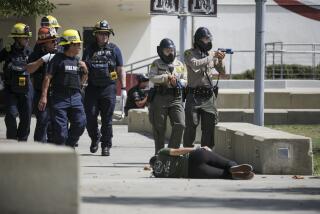Journalism Teacher Fights for Press Freedom : 1st Amendment: Over a 20-year period, Mike Wiener, who will retire next month, has taught his students at Canoga Park High the importance of using their freedom of expression.
Canoga Park High School newspaper adviser Mike Wiener’s current crop of students is carrying on journalism’s grand tradition of muckraking.
Stories and interviews in the current issue of the Canoga Park High School Hunters’ Call cast doubt on claims by authorities that no one was assaulted on campus last year. The stories follow a report in The Times last month that showed inconsistencies in the way crimes are reported at different campuses in the San Fernando Valley.
“We didn’t believe that no students were assaulted,” said Hunters’ Call reporter Brooke Farhood, a senior. “In this class right here, there were two.”
None of the Hunters’ Call staff had even started grade school when Wiener and others began their fight to extend student newspapers the same First Amendment rights as regular newspapers so stories such as the one on school crime could appear without censorship.
The state Legislature in 1978 granted students freedom of speech in their school newspapers, the first such law in the nation.
“The job of the school is to help kids to learn to read and write,” said Wiener, who is retiring next month after teaching journalism for 20 years. “I always felt there is not a better way to do that than in journalism class.”
But more than a decade later, as other states begin to imitate the California law, Wiener said he sometimes has trouble persuading his own students to use their freedom of expression.
“I ask beginning journalism students to write an editorial, and they moan and groan because in general they have no opinion on any controversial topic,” Wiener said.
Wiener said increased budgets for journalism departments to buy equipment and expanding junior high school journalism programs would attract more students and give them a better chance to learn the profession.
Wiener had been teaching journalism three years when the Los Angeles Unified School District in 1973 released its course outline for advanced journalism. Under the heading “Freedom of the Press” was an apparently contradictory policy that said, “The concept of freedom of the press does not apply to high school newspapers.”
Wiener and other members of the Los Angeles Journalism Teachers Assn. questioned the policy and, in doing so, embarked on a five-year battle for student freedoms. Along the way, Wiener had to defend his students who, for example, pasted the face of a school vice principal on the body of student radical Abbie Hoffman in an April Fool’s issue, recalled 1973 graduate Barbara Hertz, now marketing services director for the Star, a tabloid. The California law has become even more significant since a 1988 U. S. Supreme Court decision that upheld censorship by school authorities unless there is a state law specifically granting First Amendment rights to student newspapers, said Mark Goodman, an attorney for the Student Press Law Center, a nonprofit group.
“The court dramatically cut back First Amendment protections for students,” Goodman said. “So the only protection now must come from state education codes.”
Massachusetts and Iowa have since enacted laws similar to the one in California, Goodman said.
“I don’t think at the time anybody could have imagined the significance of that law,” Goodman said. “I would say that, in general, high school publications are better today thanthey’ve ever been because of it.”
More to Read
Sign up for Essential California
The most important California stories and recommendations in your inbox every morning.
You may occasionally receive promotional content from the Los Angeles Times.










